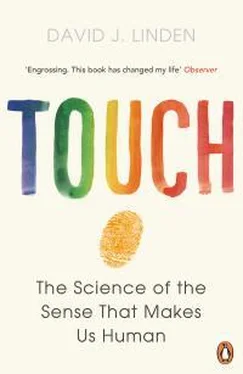Notes
PROLOGUE
1. J. B. Watson, The Psychological Care of the Infant and Child (New York: W. W. Norton & Company, 1924), 81–82. Watson continues: “Try it out. In a week’s time you will find how easy it is to be perfectly objective with your child and at the same time kindly. You will be utterly ashamed at the mawkish, sentimental way you have been handling it. If you expected a dog to grow up and be useful as a watch dog, a bird dog, a fox hound, useful for anything except a lap dog, you wouldn’t dare treat it the way you treat your child.”
CHAPTER ONE: THE SKIN IS A SOCIAL ORGAN
1. I wish that today’s academic writers were so clear and evocative. From S. E. Asch, “Forming impressions of personality,” Journal of Abnormal and Social Psychology 41 (1946): 258–90.
2. We call unemotional, potentially dangerous people “cold-blooded.” Many of us find it easy to imagine the emotional lives of warm-blooded (homoeothermic) mammals like monkeys, dogs, and cats. Yet on some level we imagine that cold fish (or lizards or snakes) are, well, “cold fish.” While we know little about the emotional lives of cold-blooded critters (called poikilotherms), we should not fall into the simple trap of imagining that theirs must be like ours, or, worse, imagining that they lack emotional lives.
3. This makes sense in a two-pass model of evaluating others. First, you want to distinguish foe from friend (or at least nonfoe), then you want to assess if that individual has the capacity to act on their intentions toward you. For a useful review, see S. T. Fiske, A. J. Cuddy, and P. Glick, “Universal dimensions of social cognition: warmth and competence,” Trends in Cognitive Science 11 (2007): 77–83.
4. R. Feldman, “Maternal touch and the developing infant,” in M. J. Hertenstein and S. J. Weiss, eds., The Handbook of Touch (New York: Springer, 2011), 373–407.
5. Importantly, just like Asch’s 1946 study, the warm coffee cup did not produce a general halo effect of goodwill. Personality descriptors that do not associate with the warm/cold dimension (like reliable/unreliable or honest/dishonest) were unaffected by the temperature of the cup. L. E. Williams and J. A. Bargh, “Experiencing physical warmth promotes interpersonal warmth,” Science 322 (2008): 606–7.
6. J. M. Ackerman, C. C. Nocera, and J. A. Bargh, “Incidental haptic sensations influence social judgments and decisions,” Science 328 (2010): 1712–15.
7. It’s useful to note that the heavier clipboard will not only produce greater activation of sensors in the skin but will also require a greater degree of contraction in the muscles of the arm, which have their own sensors and pathways to the brain. This issue will be explored in greater detail in later chapters.
8. The experimenters also asked these subjects to rate relationship familiarity of the fictional people in the passage (closeness of relationship, business-style versus casual-style interaction), and these evaluations were unaffected by the prior smooth/rough texture experience.
9. M. W. Kraus, C. Huang, and D. Keltner, “Tactile communication, cooperation and performance: an ethological study of the NBA,” Emotion 10 (2010): 745–49. It was really fun to read the detailed methods section of this paper. To wit: “Coding focused on intentional forms of touch; thus, contact resulting directly from playing basketball (e.g., fighting for position, setting screens) was not coded. In addition, due to unreliable camera angles, we chose not to code touch during slow-motion playbacks, reaction shots, timeouts, or during the end of game quarters. We focused our analysis on 12 distinct types of touch that occurred when two or more players were in the midst of celebrating a positive play that helped their team (e.g., making a shot). These celebratory touches included fist bumps, high fives, chest bumps, leaping shoulder bumps, chest punches, head slaps, head grabs, low fives, high tens, full hugs, half hugs, and team huddles.” It’s notable that butt slaps and full-on smooches were not mentioned in this analysis. Two separate coders scored each game, and a touch was scored only if both coders agreed, which occurred for 83 percent of all touches.
10. The performance metrics used in this study are interesting. For example, points scored is not a sophisticated metric: Some players may score a lot of points by taking a lot of shots and making only a moderate percentage of these, thereby turning over the ball. WinScore, the performance measure used here, accounts for the overall positive impact a player has on his team’s success by incorporating rebounds, points scored, shooting attempts, assists, blocks, and steals.
11. For a clearly written overview of coalitionary behavior and grooming in primates, see Robin Dunbar’s fine book Grooming, Gossip, and the Evolution of Language (Cambridge, MA: Harvard University Press, 1996), particularly chapter 2. Dunbar sounds the important caveat that not all primate societies exhibit coalitionary behavior. Most New World monkeys don’t, and this also holds true for some Old World lineages, like colobus monkeys and lemurs. In general, the larger the social group, the more likely that coalitionary behavior, reinforced by extensive grooming, will occur.
12. Of course, languorous baboon social life is not all about happy animals grooming one another. They can also be total assholes. Robert Sapolsky, who studies stress in baboon societies, writes, “Baboons are perfect models for the ecosystem I study. They live in the Serengeti in East Africa, which is a wonderful place for a baboon to live. They’re in big troops, so predators don’t hassle them much. Infant mortality is low. Most importantly, it takes baboons only about 3 hours of foraging to get their day’s calories. Critical implication of this—if you are spending only 3 hours in a day getting food, that means you have 9 hours of free time each day to devote to being miserable to some other baboon. Like us, they are ecologically privileged enough so that they can devote their time to generating psychological stress for each other. If a baboon in the Serengeti is miserable, it is because another baboon has worked very hard to bring that state about. ” (Italics mine.) From a 2011 interview of Robert Sapolsky by Avi Solomon on the Web site boingboing.net: http://boingboing.net/2011/11/23/robert-sapolsky-on-stress-an.html.
13. G. S. Wilkinson, “Social grooming in the common vampire bat, Desmodus rotundus ,” Animal Behavior 34 (1986): 1880–89; G. S. Wilkinson, “Food sharing in vampire bats,” Scientific American 262 (1990): 76–82.
14. The two flagship papers for this line of work are S. Levine, “Infantile experience and resistance to physiological stress,” Science 126 (1957): 405; and S. Levine, M. Alpert, and G. W. Lewis, “Infantile experience and the maturation of the pituitary adrenal axis,” Science 126 (1957): 1347. These first investigations used handling from birth to twenty-one days old, but subsequent studies revealed that the critical window is from birth to seven days old—handling starting after seven days has no significant effect. Could it be that rat pup handling is a form of maternal deprivation? This doesn’t seem likely, as over the course of the day mother rats routinely leave their nests for periods of twenty to twenty-five minutes.
15. D. Liu, J. Diorio, B. Tannenbaum, C. Caldji, D. Francis, A. Freedman, S. Sharma, D. Pearson, P. Plotsky, and M. J. Meaney, “Maternal care, hippocampal glucocorticoid receptors, and hypothalamic-pituitary-adrenal responses to stress,” Science 277 (1997): 1659–62.
16. C. Caldji, B. Tannenbaum, S. Sharma, D. Francis, P. M. Plotsky, and M. J. Meaney, “Maternal care during infancy regulates the development of neural systems mediating the expression of fearfulness in the rat,” Proceedings of the National Academy of Sciences of the United States of America 95 (1998): 5335–40; and C. Caldji, J. Diorio, and M. J. Meaney, “Variations in maternal care in infancy regulate the development of stress reactivity,” Biological Psychiatry, 48 (2000): 1164–74.
Читать дальше












